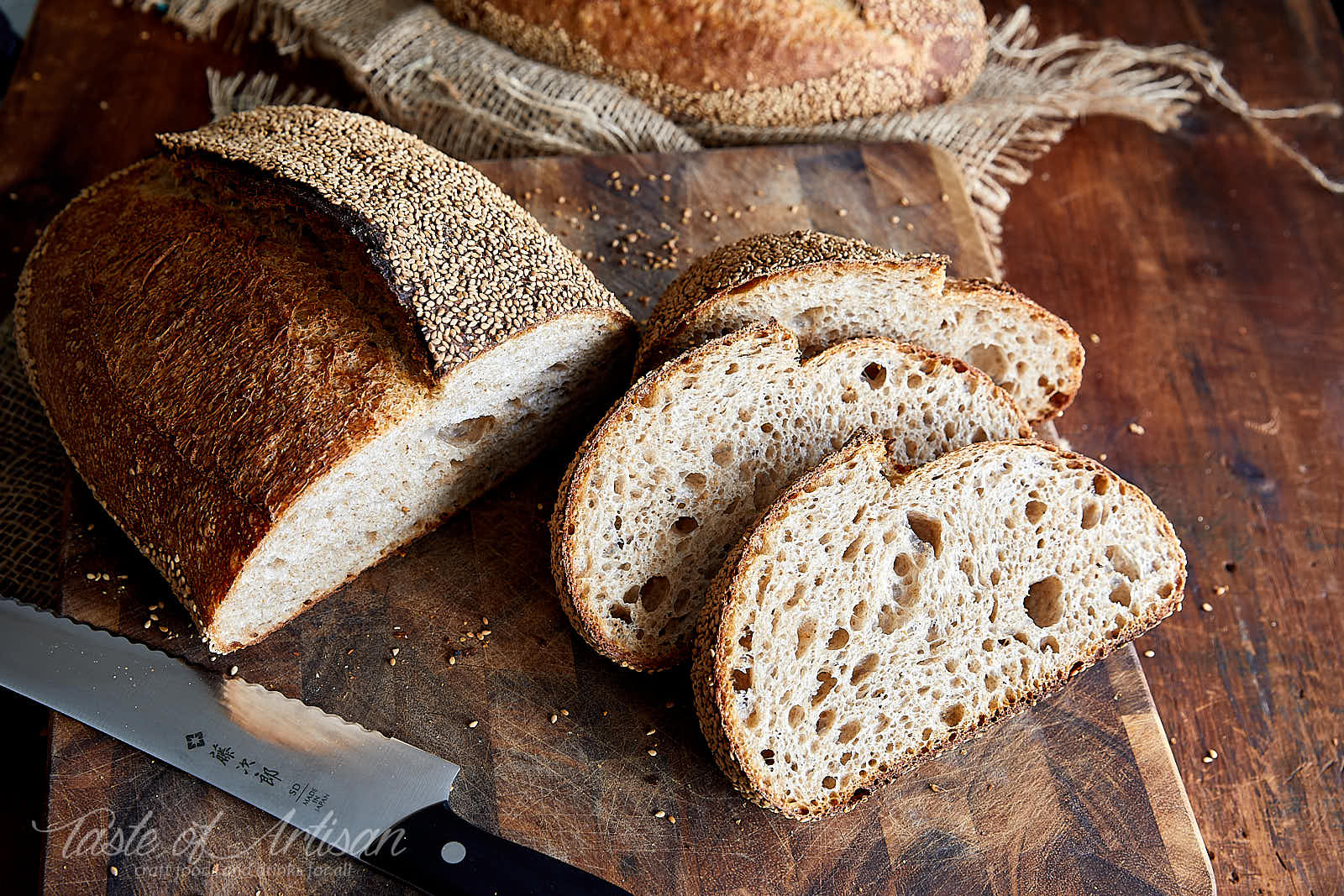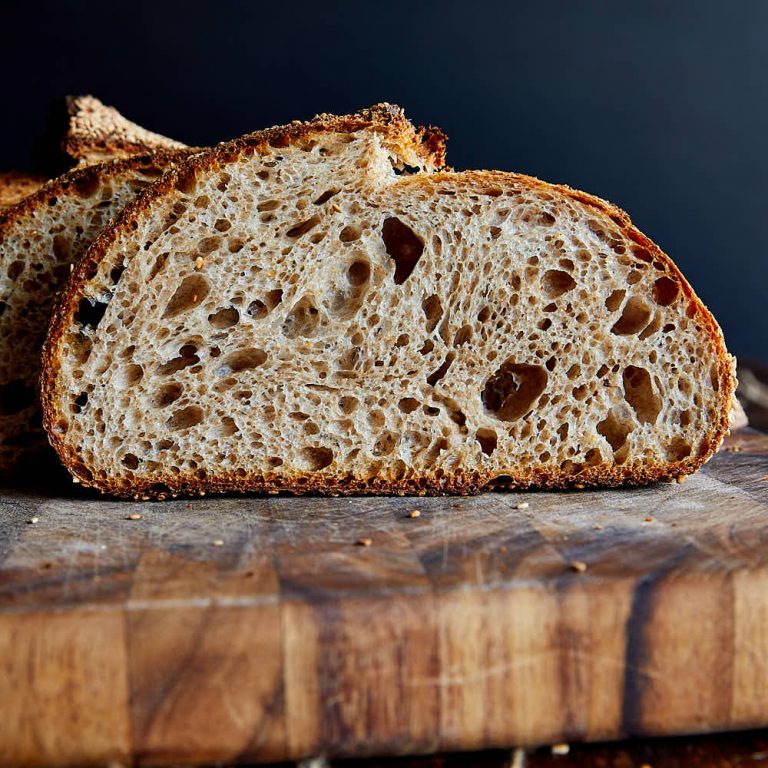Embark on a culinary journey into the world of artisan sourdough bread, where the flavors of tradition and innovation intertwine. This ancient craft, passed down through generations, invites you to create a symphony of textures and tastes that will tantalize your senses.
With its distinctive tangy flavor, chewy crumb, and golden-brown crust, sourdough bread stands as a testament to the transformative power of natural fermentation. Join us as we delve into the secrets of crafting this artisanal delight, empowering you to savor the fruits of your labor with every bite.
Ingredients and their Benefits
Artisan sourdough bread requires a few key ingredients, each playing a vital role in creating its distinctive flavor and texture.
The foundation of sourdough bread is flour, typically a blend of different types. Bread flour, with its high protein content, contributes to a chewy texture and strong gluten formation, essential for the bread’s rise. Whole wheat flour adds a nutty flavor and fiber, while rye flour imparts a tangy note and enhances the bread’s moisture retention.
Sourdough Starter
Sourdough starter, a fermented mixture of flour and water, is the heart of sourdough bread. Its wild yeast and bacteria contribute to the bread’s signature sourness and act as a natural leavening agent, causing the bread to rise without commercial yeast.
Step-by-Step s

Creating artisan sourdough bread involves a series of meticulous steps that require patience and attention to detail. This comprehensive guide will provide detailed instructions on each stage, from mixing the ingredients to baking the perfect loaf.
Before beginning, ensure you have all the necessary ingredients and equipment. A sourdough starter, which is a fermented mixture of flour and water, is essential for imparting the characteristic tangy flavor to the bread. Additionally, you will need high-quality bread flour, water, salt, and optionally, additional flavorings such as herbs or spices.
Mixing the Dough
In a large bowl, combine the sourdough starter, bread flour, and water. Mix thoroughly until a shaggy dough forms. Turn the dough out onto a lightly floured surface and knead for 5-7 minutes until it becomes smooth and elastic. The dough should be slightly sticky but not too wet.
Bulk Fermentation
Place the dough in a lightly oiled bowl, cover it with plastic wrap, and let it rise in a warm place for 12-18 hours. During this time, the sourdough starter will ferment the dough, producing carbon dioxide gas that will create air pockets and give the bread its characteristic texture.
Shaping and Proofing
Once the dough has risen, punch it down to release any excess gas. Divide the dough into two equal pieces and shape them into loaves. Place the loaves in two well-floured bannetons or proofing baskets and cover them with plastic wrap.
Let them proof for 2-3 hours, or until they have doubled in size.
Baking
Preheat the oven to 450°F (230°C). Carefully transfer the loaves to a baking sheet lined with parchment paper. Score the tops of the loaves with a sharp knife to allow for expansion during baking.
Bake for 30-35 minutes, or until the loaves are golden brown and sound hollow when tapped.
Cooling
Remove the bread from the oven and let it cool on a wire rack for at least an hour before slicing and serving.
Variations and Enhancements
Artisan sourdough bread is a versatile canvas for creativity and customization. Here are some ideas to add your own unique touch:
Experiment with different grains and seeds. Add a nutty flavor with whole wheat or rye flour, or incorporate the crunch of sunflower or flax seeds. Herbs and spices can also elevate the bread’s profile. Try adding rosemary, thyme, or even a hint of cinnamon for a warm and inviting aroma.
Adjusting for Taste Preferences
The acidity of sourdough bread can be adjusted to suit your palate. If you prefer a milder flavor, allow the dough to ferment for a shorter period. For a more pronounced sourness, extend the fermentation time.
Creating Unique Breads
Don’t be afraid to get creative with your sourdough. Try shaping it into different forms, such as baguettes, boules, or braids. You can also incorporate fillings, such as cheese, olives, or sun-dried tomatoes, to create a unique and flavorful bread that will impress your taste buds.
Troubleshooting Common Issues
The process of making artisan sourdough bread can present challenges, but understanding and addressing common issues can help you achieve a perfect loaf.
If your bread is dense, undercooked, or excessively sour, here are some troubleshooting tips to guide you.
Dense Bread
- Over-proofing: Allow the dough to rise until it has doubled in size, but avoid over-proofing, as it can weaken the gluten structure and result in a dense loaf.
- Insufficient kneading: Kneading develops the gluten network, which gives bread its structure. Knead the dough thoroughly to ensure proper gluten development.
- Too much water: A high hydration level can make the dough difficult to handle and lead to a dense loaf. Adjust the water content gradually until you achieve a dough that is slightly sticky but not overly wet.
Undercooked Bread
- Insufficient baking time: Ensure the bread is baked for the recommended time or until it reaches an internal temperature of 205-210°F (96-99°C).
- Underproofed dough: If the dough is not allowed to rise sufficiently before baking, it may not have enough time to develop the gases that give it a light and airy texture.
- Incorrect oven temperature: Calibrate your oven to ensure it is heating accurately. An oven that is too hot can burn the outside of the bread while leaving the inside undercooked.
Excessive Sourness
- Long fermentation: While sourdough bread is naturally sour, excessively long fermentation can result in an overpowering sourness. Control the fermentation time to achieve a balance of flavors.
- Too much starter: Using too much starter can introduce an excessive amount of acidity into the dough. Adjust the starter quantity according to the recipe and your desired sourness level.
- Low-quality flour: The quality of the flour can affect the sourness of the bread. Use high-quality bread flour or a blend of bread flour and whole wheat flour for a milder flavor.
Health Benefits and Nutritional Value

Artisan sourdough bread offers a rich nutritional profile that sets it apart from other bread varieties. It is a good source of complex carbohydrates, providing sustained energy throughout the day. Additionally, it contains a variety of vitamins, minerals, and fiber.
Gut Health
The fermentation process involved in sourdough bread production creates beneficial probiotics, which support gut health. These probiotics help improve digestion, reduce inflammation, and strengthen the immune system.
Blood Sugar Control
The low glycemic index of sourdough bread makes it a suitable choice for individuals with blood sugar concerns. It releases glucose slowly into the bloodstream, preventing spikes in blood sugar levels.
Overall Well-being
Sourdough bread is a nutrient-dense food that contributes to overall well-being. It provides essential vitamins and minerals, including B vitamins, iron, and magnesium. These nutrients support energy production, cognitive function, and muscle health.
Last Word
As you embark on your sourdough bread-making adventures, remember that each loaf tells a unique story. Embrace the nuances of fermentation, experiment with different ingredients, and find joy in the process. May your kitchen become a haven of culinary exploration, where the aroma of freshly baked bread fills the air and nourishes your soul.
FAQ Section
What is the secret to a perfect sourdough crust?
The key lies in creating steam during the baking process. Preheating your oven with a Dutch oven or baking stone helps trap steam, resulting in a crisp and flavorful crust.
How can I enhance the sour flavor of my sourdough bread?
Extend the fermentation time of your sourdough starter. The longer it ferments, the more lactic acid and acetic acid will develop, contributing to a more pronounced sourness.
What is the ideal hydration level for sourdough bread?
The optimal hydration level varies depending on the flour you use. Start with a hydration level of 70-75% and adjust as needed. A higher hydration level results in a more open crumb, while a lower hydration level yields a denser bread.
